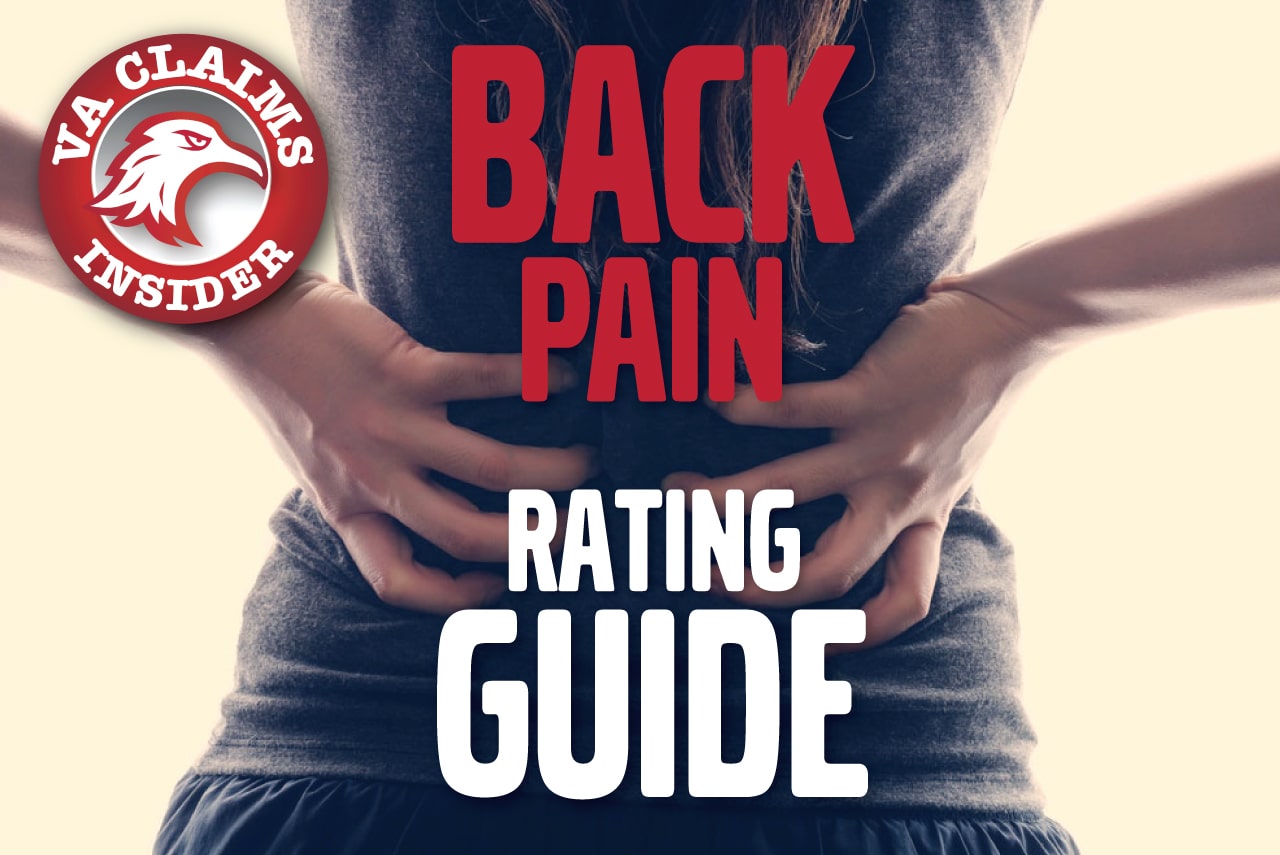VA Disability Ratings for Back Pain – The Definitive Guide

Hi Veterans, in this post, I will be covering VA disability ratings for back pain criteria in detail.
Many veterans suffer from various back conditions due to their active duty military service and perhaps you’re wondering if you can get VA disability for back pain.
Generally, VA disability ratings for back pain range from 10% to 100% and depend upon the frequency, severity, and duration of symptoms, including Painful Motion, Limitation of Range of Motion (ROM), and Functional Loss or Impairment.
In addition, Back Pain is a common secondary VA disability claim, especially Radiculopathy secondary to back conditions or back pain.
Okay, let’s jump into some important definitions first because these principles are critical to understand and may affect your final VA disability rating for back pain.
- WATCH: How to Maximize VA Disability Ratings for Back Pain!
- What is the “Painful Motion” Principle?
- Full definition of §4.59, Painful Motion
- What is “Limitation of Range of Motion” for VA disability for back pain?
- §4.46, Accurate Measurement of Limitation of Range of Motion
- 2020 VA Disability Ratings for Back Pain Explained
- What is “Functional Loss” in a VA disability claim for back pain?
- §4.40, Functional Loss Full Definition
- VA Disability Ratings for Back Pain – 10% to 100%
- Is Back Pain a VA disability?
- VA Rating for Back Pain
- Can I be rated for more than one VA disability for back?
- List of VA Secondary Conditions to Back Pain
- About The Author
WATCH: How to Maximize VA Disability Ratings for Back Pain!
What is the “Painful Motion” Principle?
The painful motion principle means that regardless of range of motion, if pain is present, the claimant should at least be awarded the minimum level of disability for that condition.
For example, let’s say you have full range of motion for your back, but you have pain during movement, you should be awarded the minimum level of disability for the condition, which for most muscuoloskeltal conditions is 10%.
Full definition of §4.59, Painful Motion
With any form of arthritis, painful motion is an important factor of disability, the facial expression, wincing, etc., on pressure or manipulation, should be carefully noted and definitely related to affected joints.
Muscle spasm will greatly assist the identification.
Sciatic neuritis is not uncommonly caused by arthritis of the spine.
The intent of the schedule is to recognize painful motion with joint or periarticular pathology as productive of disability.
It is the intention to recognize actually painful, unstable, or malaligned joints, due to healed injury, as entitled to at least the minimum compensable rating for the joint.
Crepitation either in the soft tissues such as the tendons or ligaments, or crepitation within the joint structures should be noted carefully as points of contact which are diseased.
Flexion elicits such manifestations.
The joints involved should be tested for pain on both active and passive motion, in weight-bearing and non-weight-bearing and, if possible, with the range of the opposite undamaged joint.
What is “Limitation of Range of Motion” for VA disability for back pain?
The limitation of range of motion principle is arguably the most important principle that applies to VA disability ratings for back pain.
Why?
Because the general rating formula for diseases and injuries of the spine talk about “flexion,” which is the act of flexing or bending.
Any limitation of Range of Motion (ROM) should be measured with a Goniometer by the medical professional at your VA C&P Exam for Back Pain.
You must be open, honest, and truthful at your C&P exam for back pain, and make sure to STOP the C&P examiner as soon as you feel any pain.
If you can’t move at all without pain, make sure to let the examiner know that.
§4.46, Accurate Measurement of Limitation of Range of Motion
Accurate measurement of the length of stumps, excursion of joints, dimensions, and location of scars with respect to landmarks, should be insisted on.
The use of a goniometer in the measurement of limitation of motion is indispensable in examinations conducted within the Department of Veterans Affairs.

Muscle atrophy must also be accurately measured and reported.
You’ll also see the term “Unfavorable Ankylosis,” which is a condition in which the entire cervical spine, the entire thoracolumbar spine, or the entire spine is fixed in flexion or extension, and the ankylosis results in one or more of the following:
- Difficulty walking because of a limited line of vision
- Restricted opening of the mouth and chewing
- Breathing limited to diaphragmatic respiration
- Gastrointestinal symptoms due to pressure of the coastal margin on the abdomen
- Dyspnea or dysphagia
- Alantoaxial or cervical subluxation or dislocation
- Neurologic symptoms due to nerve root stretching
2020 VA Disability Ratings for Back Pain Explained

- 100% VA Disability for Back Pain: Unfavorable ankylosis of the entire spine
- 50% VA Disability Rating for Back Pain: Unfavorable ankylosis of the entire thoracolumbar spine
- 40% VA Rating for Back Pain: Unfavorable ankylosis of the entire cervical spine; or, forward flexion of the thoracolumbar spine 30 degrees or less; or, favorable ankylosis of the entire thoracolumbar spine
- 30% VA Rating for Back Pain: Forward flexion of the cervical spine 15 degrees or less; or, favorable ankylosis of the entire cervical spine
- 20% VA Disability Rating for Back: Forward flexion of the thoracolumbar spine greater than 30 degrees but not greater than 60 degrees; or, forward flexion of the cervical spine greater than 15 degrees but not greater than 30 degrees; or, the combined range of motion of the thoracolumbar spine not greater than 120 degrees; or, the combined range of motion of the cervical spine not greater than 170 degrees; or, muscle spasm or guarding severe enough to result in an abnormal gait or abnormal spinal contour such as scoliosis, reversed lordosis, or abnormal kyphosis
- 10% VA Rating for Back Pain: Forward flexion of the thoracolumbar spine greater than 60 degrees but not greater than 85 degrees; or, forward flexion of the cervical spine greater than 30 degrees but not greater than 40 degrees; or, combined range of motion of the thoracolumbar spine greater than 120 degrees but not greater than 235 degrees; or, combined range of motion of the cervical spine greater than 170 degrees but not greater than 335 degrees; or, muscle spasm, guarding, or localized tenderness not resulting in abnormal gait or abnormal spinal contour; or, vertebral body fracture with loss of 50 percent or more of the height
*If no limitation of range of motion is observed, but the claimant has painful motion, the minimum rating or 10% should be applied.
>> Read the complete VA Spine Examination guide here <<
What is “Functional Loss” in a VA disability claim for back pain?
VA disability ratings for back pain also depend upon “Functional Loss,” which means impairment of spine function as determined by range of motion as reported in the physical examination and additional loss of range of motion after repetitive use caused by the following factors:
#1. Pain
#2. Fatigue
#3. Weakness
#4. Lack of endurance
#5. Incoordination
§4.40, Functional Loss Full Definition
Disability of the musculoskeletal system is primarily the inability, due to damage or infection in parts of the system, to perform the normal working movements of the body with normal excursion, strength, speed, coordination and endurance.
It is essential that the examination on which ratings are based adequately portray the anatomical damage, and the functional loss, with respect to all these elements.
The functional loss may be due to absence of part, or all, of the necessary bones, joints and muscles, or associated structures, or to deformity, adhesions, defective innervation, or other pathology, or it may be due to pain, supported by adequate pathology and evidenced by the visible behavior of the claimant undertaking the motion.
Weakness is as important as limitation of motion, and a part which becomes painful on use must be regarded as seriously disabled.
A little used part of the musculoskeletal system may be expected to show evidence of disuse, either through atrophy, the condition of the skin, absence of normal callosity or the like.
VA Disability Ratings for Back Pain – 10% to 100%
| General Rating Formula for Diseases and Injuries of the Spine | VA Rating for Back Pain |
| Unfavorable ankylosis of the entire spine | 100% |
| Unfavorable ankylosis of the entire thoracolumbar spine | 50% |
| Unfavorable ankylosis of the entire cervical spine; or, forward flexion of the thoracolumbar spine 30 degrees or less; or, favorable ankylosis of the entire thoracolumbar spine | 40% |
| Forward flexion of the cervical spine 15 degrees or less; or, favorable ankylosis of the entire cervical spine | 30% |
| Forward flexion of the thoracolumbar spine greater than 30 degrees but not greater than 60 degrees; or, forward flexion of the cervical spine greater than 15 degrees but not greater than 30 degrees; or, the combined range of motion of the thoracolumbar spine not greater than 120 degrees; or, the combined range of motion of the cervical spine not greater than 170 degrees; or, muscle spasm or guarding severe enough to result in an abnormal gait or abnormal spinal contour such as scoliosis, reversed lordosis, or abnormal kyphosis | 20% |
| Forward flexion of the thoracolumbar spine greater than 60 degrees but not greater than 85 degrees; or, forward flexion of the cervical spine greater than 30 degrees but not greater than 40 degrees; or, combined range of motion of the thoracolumbar spine greater than 120 degrees but not greater than 235 degrees; or, combined range of motion of the cervical spine greater than 170 degrees but not greater than 335 degrees; or, muscle spasm, guarding, or localized tenderness not resulting in abnormal gait or abnormal spinal contour; or, vertebral body fracture with loss of 50 percent or more of the height | 10% |
| Evaluate intervertebral disc syndrome (preoperatively or postoperatively) either under the General Rating Formula for Diseases and Injuries of the Spine or under the Formula for Rating Intervertebral Disc Syndrome Based on Incapacitating Episodes, whichever method results in the higher evaluation when all disabilities are combined under §4.25. | |
| Formula for Rating Intervertebral Disc Syndrome Based on Incapacitating Episodes | VA Rating for Intervertebral Disc Syndrome |
| With incapacitating episodes having a total duration of at least 6 weeks during the past 12 months | 60% |
| With incapacitating episodes having a total duration of at least 4 weeks but less than 6 weeks during the past 12 months | 40% |
| With incapacitating episodes having a total duration of at least 2 weeks but less than 4 weeks during the past 12 months | 20% |
| With incapacitating episodes having a total duration of at least one week but less than 2 weeks during the past 12 months | 10% |
| Note (1): For purposes of evaluations under diagnostic code 5243, an incapacitating episode is a period of acute signs and symptoms due to intervertebral disc syndrome that requires bed rest prescribed by a physician and treatment by a physician. | |
| Note (2): If intervertebral disc syndrome is present in more than one spinal segment, provided that the effects in each spinal segment are clearly distinct, evaluate each segment on the basis of incapacitating episodes or under the General Rating Formula for Diseases and Injuries of the Spine, whichever method results in a higher evaluation for that segment. |
Is Back Pain a VA disability?
Yes, VA disability for back condition is a ratable condition under the law and ratings range from 10% to 100% depending upon the severity of your symptoms.
VA Rating for Back Pain
Veterans can download an image of the VA rating for back pain infographic below, which describes the VA disability ratings for back pain from 0% to 100% with breaks at 10%, 20%, 40%, and 50%.

Can I be rated for more than one VA disability for back?
The legal concept “Avoidance of Pyramiding” applies to the back just like any other VA disability.
However, you can be rated for more than one disability condition for your back that cause different levels of impairment and are clearly separately rated conditions.
For example, you may have a 50% VA rating for your back due to unfavorable ankylosis of the entire thoracolumbar spine.
Perhaps this condition has also led to Radiculopathy, which occurs when nerve roots become pinched or damaged, the resulting symptoms lead to this painful condition.
>> Click HERE to learn about VA Disability Ratings for Radiculopathy <<
List of VA Secondary Conditions to Back Pain
Many veterans suffer from various service connected back conditions, which can affect your back.
For example, the following codes from 38 CFR, Part 4, Schedule for Rating Disabilities apply:
- Code 5237: Lumbosacral or cervical strain—a generic label for back pain
- Code 5238: Spinal stenosis—the spinal column narrows and presses on the spinal cord or nerves
- Code 5239: Spondylolisthesis or segmental instability—when a vertebra slips out of position
- Code 5240: Ankylosing spondylitis—an arthritic disease that causes the spinal joints to freeze in place
- Code 5241: Spinal fusion—the vertebrae are surgically fused together
- Code 5235: Vertebral fracture or dislocation—the bones of the spine break or slip out of alignment due to a traumatic event like a car accident. Any generic spinal bone injury would be coded here.
These six back conditions can often lead to pinched or damaged nerve roots, which can cause significant pain known as Radiculopathy.
Radiculopathy is commonly rated as a secondary VA disability claim for secondary service connection due to one or more service connected back conditions.
Note that a veteran is eligible to be rated for both a back condition, and Radiculopathy secondary to lower back pain.
About The Author
Brian Reese is a VA disability expert, former military officer, and founder of VA Claims Insider – “The Most Trusted Name in Education-Based Resources for Veterans.”
Learn more About VA Claims Insider HERE.
>> Wondering “Is VA Claims Insider Legit?” CLICK HERE to learn more <<
Brian’s frustration with the 8-step VA disability claims process led him to create “VA Claims Insider,” which provides disabled veterans with tips, strategies, and lessons learned to win their VA disability compensation claim in less time.

He is also the CEO of Military Disability Made Easy, which is the world’s largest free searchable database for all things related to DoD disability and VA disability, and has served more than 6,000,000 military members and veterans since its founding in 2013.
Veterans can download one of his #1 rated and most downloaded FREE eBooks online: “The Secret Guide to 833 Ratable VA Disabilities” by clicking HERE now.
Brian is a former active duty Air Force officer with extensive experience leading hundreds of individuals and multi-functional teams in challenging international environments, including a combat tour to southern Afghanistan in 2011 in support of Operation ENDURING FREEDOM.
He is a Distinguished Graduate of Management from the United States Air Force Academy, Colorado Springs, CO and he holds an MBA from Oklahoma State University’s Spears School of Business, Stillwater, OK, where he was a National Honor Scholar (Top 1% of Graduate School class).

